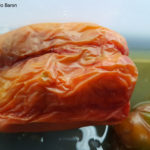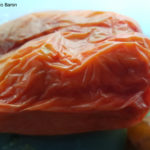.
Condición fitosanitaria: Presente
Grupo de cultivos: Hortícolas
Especie hospedante: Pimiento (Capsicum annuum var. annuum)
Etiología: Bacteria. Gram negativa
Agente causal: Pectobacterium carotovorum subsp. carotovorum (Jones, 1901) Waldee, 1945
homotypic synonym:
Erwinia carotovora subsp. carotovora (Jones 1901) Bergey et al. 1923 (Approved lists 1980) (Jones 1901) Bergey et al. 1923 (Approved Lists 1980), nom. approb
Taxonomía: Bacteria > Proteobacteria > Gammaproteobacteria > Enterobacteriales > Enterobacteriaceae > Pectobacterium > Pectobacterium carotovorum
.
.
.
Sintomatología
.
.
.
.
.
Bibliografía
Cui W, He P, Munir S, et al. (2019) Biocontrol of Soft Rot of Chinese Cabbage Using an Endophytic Bacterial Strain. Front. Microbiol. 10:1471. https://doi.org/10.3389/fmicb.2019.01471
Gašić K, Gavrilović V, Dolovac N, et al. (2014) Pectobacterium carotovorum subsp. carotovorum – the causal agent of broccoli soft rot in Serbia. Pestic. Phytomed. (Belgrade), 29(4): 249–255. DOI: 10.2298/PIF1404249G
Gillis A, Santana MA, Rodríguez M, Romay G (2017) First Report of Bell Pepper Soft-Rot Caused by Pectobacterium carotovorum subsp. brasiliense in Venezuela. Plant Disease 101:9, 1671-1671. https://doi.org/10.1094/PDIS-03-17-0361-PDN
Golkhandan E, Kamaruzaman S, Sariah M, et al. (2013) First Report of Soft Rot Caused by Pectobacterium carotovorum subsp. carotovorum on Pepper Fruits (Capsicum annuum) in Malaysia. Plant Disease 97:8, 1109-1109. https://doi.org/10.1094/PDIS-01-13-0042-PDN
Haque MM, Oliver MMH, Nahar K, et al. (2017) CytR Homolog of Pectobacterium carotovorum subsp. carotovorum Controls Air-Liquid Biofilm Formation by Regulating Multiple Genes Involved in Cellulose Production, c-di-GMP Signaling, Motility, and Type III Secretion System in Response to Nutritional and Environmental Signals. Front. Microbiol. 8:972. doi: 10.3389/fmicb.2017.00972
Li X, Fu L, Chen C, et al. (2020) Characteristics and Rapid Diagnosis of Pectobacterium carotovorum ssp. Associated With Bacterial Soft Rot of Vegetables in China. Plant Dis. 104(4): 1158-1166. doi: 10.1094/PDIS-05-19-1033-RE
Lu Q, Yan F, Liu Y, Li Q, Yang M, Liu P (2021) Comparative Genomic Analyses Reveal Functional Insights Into Key Determinants of the Pathogenesis of Pectobacterium actinidiae in Kiwifruit. Phytopathology. doi: 10.1094/PHYTO-07-20-0287-R
Ma B, Hibbing ME, Kim HS, et al. (2007) Host range and molecular phylogenies of the soft rot enterobacterial genera Pectobacterium and Dickeya. Phytopathology. 97(9): 1150–1163. doi: 10.1094/PHYTO-97-9-1150
Nabhan S, De Boer S, Maiss E, Wydra K (2012) Taxonomic relatedness between Pectobacterium carotovorum subsp. carotovorum, Pectobacterium carotovorum subsp. odoriferum and Pectobacterium carotovorum subsp. brasiliense subsp. nov. J Appl Microbiol 113: 904-913. doi:10.1111/j.1365-2672.2012.05383.x
, (2023) Field surveys indicate taxonomically diverse Pectobacterium species inducing soft rot of vegetables and annual crops in Iran. Plant Pathology 00: 1– 12. doi: 10.1111/ppa.13735
Terán Baptista ZP, de Los Angeles Gómez A, Kritsanida M, et al. (2020) Antibacterial activity of native plants from Northwest Argentina against phytopathogenic bacteria. Nat Prod Res. 34(12): 1782-1785. doi: 10.1080/14786419.2018.1525716
Waleron M, Waleron K, Lojkowska E (2014) Characterization of Pectobacterium carotovorum subsp. odoriferum causing soft rot of stored vegetables. European Journal of Plant Pathology 139: 457. https://doi.org/10.1007/s10658-014-0403-z
, , , et al. (2020) Pectobacterium atrosepticum KDPG aldolase, Eda, participates in the Entner–Doudoroff pathway and independently inhibits expression of virulence determinants. Molecular Plant Pathology 22: 271– 283. https://doi.org/10.1111/mpp.13025

